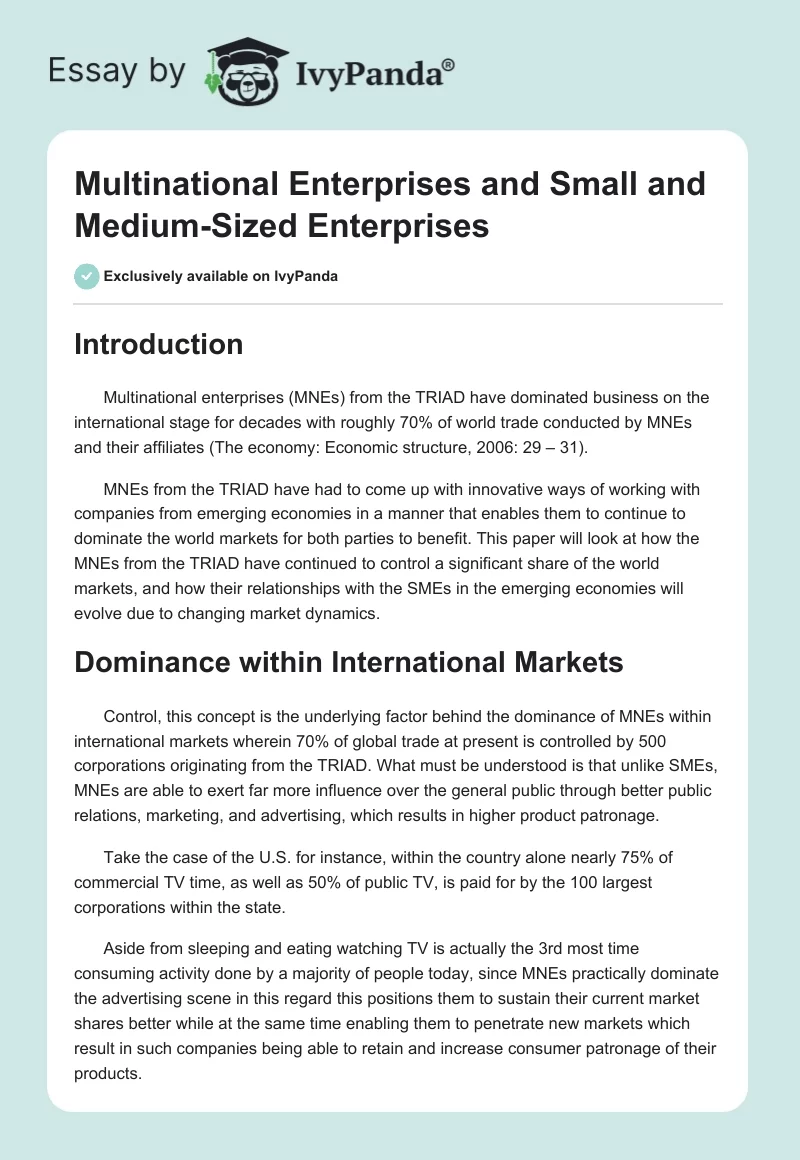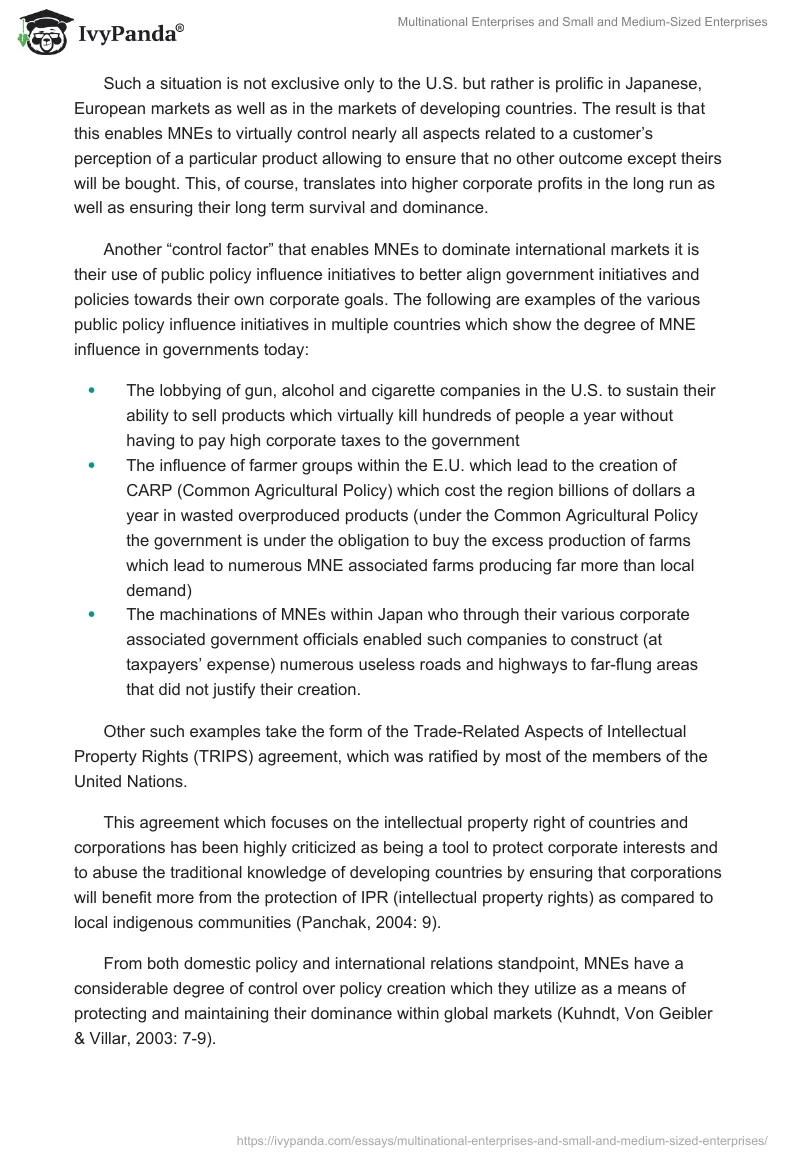Introduction
Multinational enterprises (MNEs) from the TRIAD have dominated business on the international stage for decades with roughly 70% of world trade conducted by MNEs and their affiliates (The economy: Economic structure, 2006: 29 – 31).
MNEs from the TRIAD have had to come up with innovative ways of working with companies from emerging economies in a manner that enables them to continue to dominate the world markets for both parties to benefit. This paper will look at how the MNEs from the TRIAD have continued to control a significant share of the world markets, and how their relationships with the SMEs in the emerging economies will evolve due to changing market dynamics.
Dominance within International Markets
Control, this concept is the underlying factor behind the dominance of MNEs within international markets wherein 70% of global trade at present is controlled by 500 corporations originating from the TRIAD. What must be understood is that unlike SMEs, MNEs are able to exert far more influence over the general public through better public relations, marketing, and advertising, which results in higher product patronage.
Take the case of the U.S. for instance, within the country alone nearly 75% of commercial TV time, as well as 50% of public TV, is paid for by the 100 largest corporations within the state.
Aside from sleeping and eating watching TV is actually the 3rd most time consuming activity done by a majority of people today, since MNEs practically dominate the advertising scene in this regard this positions them to sustain their current market shares better while at the same time enabling them to penetrate new markets which result in such companies being able to retain and increase consumer patronage of their products.
Such a situation is not exclusive only to the U.S. but rather is prolific in Japanese, European markets as well as in the markets of developing countries. The result is that this enables MNEs to virtually control nearly all aspects related to a customer’s perception of a particular product allowing to ensure that no other outcome except theirs will be bought. This, of course, translates into higher corporate profits in the long run as well as ensuring their long term survival and dominance.
Another “control factor” that enables MNEs to dominate international markets it is their use of public policy influence initiatives to better align government initiatives and policies towards their own corporate goals. The following are examples of the various public policy influence initiatives in multiple countries which show the degree of MNE influence in governments today:
- The lobbying of gun, alcohol and cigarette companies in the U.S. to sustain their ability to sell products which virtually kill hundreds of people a year without having to pay high corporate taxes to the government
- The influence of farmer groups within the E.U. which lead to the creation of CARP (Common Agricultural Policy) which cost the region billions of dollars a year in wasted overproduced products (under the Common Agricultural Policy the government is under the obligation to buy the excess production of farms which lead to numerous MNE associated farms producing far more than local demand)
- The machinations of MNEs within Japan who through their various corporate associated government officials enabled such companies to construct (at taxpayers’ expense) numerous useless roads and highways to far-flung areas that did not justify their creation.
Other such examples take the form of the Trade-Related Aspects of Intellectual Property Rights (TRIPS) agreement, which was ratified by most of the members of the United Nations.
This agreement which focuses on the intellectual property right of countries and corporations has been highly criticized as being a tool to protect corporate interests and to abuse the traditional knowledge of developing countries by ensuring that corporations will benefit more from the protection of IPR (intellectual property rights) as compared to local indigenous communities (Panchak, 2004: 9).
From both domestic policy and international relations standpoint, MNEs have a considerable degree of control over policy creation which they utilize as a means of protecting and maintaining their dominance within global markets (Kuhndt, Von Geibler & Villar, 2003: 7-9).
The last way in which TRIAD MNE’s have sustained their dominance within international markets has been through their superior supply chain and capital (Sullivan & Bauerschmidt, 1991: 111-124). These companies are able to not only obtain various resources from a variety of locations cheaply and quickly but through their supply chain are able to manufacture and deliver their products to customers at an astounding rate (James, 2011: 52).
Coupled with their considerable capital, these companies are able to weather the “storm” of fluctuating markets, enabling them to become dominant forces in the global economy (Lee, 2002: 32).
Evidence of this can be seen in the way in which the 2008 financial crisis only “hampered” the operations of many MNEs, but within 2 years, they were making considerable profits in no time. This was unlike the situation SMEs at the time wherein hundreds if not thousands of SMEs around the world closed as a direct result of the impact of the financial crisis on their client base.
The relationship between MNEs within the TRIAD and SMEs in low-cost economies
When examining the relationship between MNEs within the TRIAD it can roughly be described as a “love/hate relationship” wherein where the interests of MNEs coincide there is a more significant deal of cooperation and mutual respect for the other however in cases of direct competition there is of course instances of direct conflict which more often than not results in adverse relationships (Muchlinski, 2011: 665).
In the case of MNEs and SMEs within low-cost economies, it can be examined in terms of the “core and periphery system” wherein MNEs act as the core supplying completed products to the periphery which in turn serve as selling such products to their customers (Polak, 2006: 13).
Another relationship in this regard is when the MNEs (still acting as the core) outsource to SMEs (the periphery) in order to lower their business expenditures. In this particular case it the relationship takes the form of a supply linkage were in all examples provided the core benefits more from the relationship than the periphery.
Evolution of the Relationship of relationships between the TRIAD MNEs and SMEs within China, India, and Brazil
There are many ways in which the relationship between TRIAD MNEs and SMEs within China, India, and Brazil can be defined however for this paper they will be examined from the context of supply/service linkages. First and foremost, what must be understood is that TRIAD MNEs often outsource various aspects of their production processes to SMEs within China, India, and Brazil.
The reason behind this is quite simple; producing various products is far cheaper in these countries as compared to providing the same products in the U.S., Europe or Japan. Labor costs are considerably less expensive as well as the cost of utilities, and local government taxes are often far less as compared to that of 1st world countries (Wang, & Ralston, 2000:677-701).
This has resulted in the modern-day trend of a large percentage of MNEs closing down their local production plants and transferring them to India, China, and Brazil.
What must be understood though is that this relationship between TRIAD MNEs and the SMEs within the indicated countries all hinges on the fact that production in these countries is far cheaper as compared to that of the TRIAD. Should other cheaper alternatives present themselves, it would be logical to assume that MNEs would shift their operations to these new locations (Gao, 2009: 13).
One example where this is occurring in the present can be seen in the case between the Philippines and India. For years India has been the “go-to” location for the outsourcing of back-office processes and customer service centers due to its well-established I.T. infrastructure and English speaking population. Yet within the past 5 years, the Philippines has overtaken India as the location of choice for the establishment of new call centers and off-shored back offices.
Other such examples can be seen in the case of Vietnam, Indonesia, Cambodia and other countries located within the Asia-Pacific region wherein due to improvements in their local industrial sectors local SMEs have slowly but surely begun to build up an entourage of MNE clients at the expense of India, China, and Brazil.
When taking this into consideration, it is evident that the evolution of such a relationship is that eventually TRIAD MNEs will merely have SMEs within China, India, and Brazil as distributors of their products and will not use them at all for the production of their goods or services. On the other hand, another possible result would be that TRIAD MNEs would further deepen their relationship with SMEs in Brazil, China, and India as a means of ensuring reliability within their supply chain in order to better supply emerging economies.
The reason behind is connected to the fact that the “grey market” (this consists of various personally owned stands, stalls, and unregulated stores within a variety of emerging economies) have been shown to account for 3/4ths of all local trade within a range of countries. When examining the numbers, the “grey market” in some countries (mainly India, China, and Brazil) brings in millions of dollars in revenue per month.
When examining such a phenomenon in action various MNEs such as Coca Cola, Nestle, Unilever, etc. support such SMEs by continuing to do business with them through multiple distribution centers.
With various reports showing the continued growth of the grey economy in different emerging low cost economies the end result could be that MNEs might continue to establish relationships with India, China, and Brazil as a means of servicing the needs of this particular market segment given the geographic location of the aforementioned countries which enables them to directly trade with grey market distributors.
Conclusion
Based on the information presented in this paper it can be seen that MNEs will continue to be the dominant players in the global economy by their supply chain, capital expenditures and influence in both government and international policies as well and marketing/advertising initiatives.
With the emergence of new low cost economies it is likely that MNEs will shift resources to either outsource in these economies instead of in Brazil, India, and China (as seen in the case of the Philippines) or they will try to meet the demand of the emerging grey market through better-established production and distribution centers in the aforementioned countries.
Reference List
Gao, TE 2009, ‘What Causes Multinational Companies to Increase Resource Commitments During Financial Crises in Emerging Markets?’, Multinational Business Review (St. Louis University), 17, 2, p. 13, MasterFILE Premier, EBSCOhost.
James, D 2011, ‘PLAY WITH THE BIG BOYS’, Brw, 33, 3, p. 52, MasterFILE Premier, EBSCOhost.
Kuhndt, M, Von Geibler, J, & Villar, A 2003, ‘Challenges for SMEs in a globalized world economy’, Industry & Environment, 26, 4, pp. 7-9, GreenFILE, EBSCOhost.
Lee, J 2002, ‘China, Here We Come’, Asian Business, 38, 2, p. 32, Business Source Premier, EBSCOhost.
Muchlinski, P 2011, ‘The Changing Face of Transnational Business Governance: Private Corporate Law Liability and Accountability of Transnational Groups in a Post-Financial Crisis World’, Indiana Journal Of Global Legal Studies, 18, 2, pp. 665-705, Academic Search Premier, EBSCOhost.
Panchak, P 2004, ‘Fanning Protectionism’s Flames’, Industry Week/IW, 253, 6, p. 9, MasterFILE Premier, EBSCOhost,
Polak, R 2006, ‘The Goldilocks approach to international benefits’, Employee Benefit News, 20, 13, pp. 16-18, Business Source Premier, EBSCOhost.
Sullivan, D, & Bauerschmidt, A 1991, ‘The “Basic Concepts” ot International Business Strategy: A Review and Reconsideration’, Management International Review (MIR), 31, 4, pp. 111-124, Business Source Premier, EBSCOhost.
‘The economy: Economic structure’ 2006, Country Profile. Japan, pp. 29-31, Business Source Premier, EBSCOhost.
Wang, X, & Ralston, D 2000, ‘Strategies for Small and Medium-Sized U.S. Businesses Investing in China: Lessons from Taiwanese Companies’, Thunderbird International Business Review, 42, 6, pp. 677-701, Business Source Premier, EBSCOhost.


